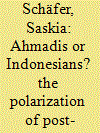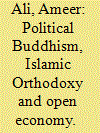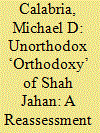| Srl | Item |
| 1 |
ID:
157939


|
|
|
|
|
| Summary/Abstract |
Since the fall of Suharto in 1998, Indonesian public discourse about “mainstream” Muslim identity and practice has polarized sharply into various factions. This article offers a detailed analysis of a subset of this discourse that focuses on the Ahmadiyya in order to grasp how the new normative contours of Islam are being shaped in Indonesia. I make three arguments: First, the discourse is homogenizing what was once a wide spectrum of identitarian positions, and that consequently, Islamic diversity in Indonesia is shrinking. Second, the various internally homogenized sets of arguments for and against the Ahmadiyya mis-engage with each other in a way that produces social fragmentation and further polarization. Third, these arguments produce exclusionary mechanisms that reinforce each other. Both the opponents of the Ahmadiyya and their defenders exclude Ahmadis from conceptions of an Indonesian “majority.” This dynamic in Indonesian public discourse has resulted in the acceleration of the marginalization of the Ahmadiyya within an increasingly fragmented Indonesian society.
|
|
|
|
|
|
|
|
|
|
|
|
|
|
|
|
| 2 |
ID:
132311


|
|
|
|
|
| Publication |
2014.
|
| Summary/Abstract |
After nearly a millennium of uninterrupted harmony between the Sinhalese and Muslims in Sri Lanka, economic and ethno-religious developments after the 1970s have created an atmosphere of communal tension between the two groups. While a new wave of political Buddhism with its militant offshoot amongst the Sinhalese and the growth of a rigid Islamic orthodoxy amongst the Muslims have provided the ethno-religious dimension to this tension, the post-1977 open economy has added an economic dimension to it. The interplay of this toxic triad is a reminder of a similar scenario that produced the first Sinhalese-Muslim racial riots in the country in 1915. Unlike the first, which occurred in the colonial context, the current one, which if not arrested, will not only jeopardize Sinhalese-Muslim harmony but also will result in adverse consequences in Sri Lanka's relations with Muslim countries.
|
|
|
|
|
|
|
|
|
|
|
|
|
|
|
|
| 3 |
ID:
162465


|
|
|
|
|
| Summary/Abstract |
In spite of the many beautiful works of art and architecture produced under the patronage of the Mughal emperor Shah Jahan (r. 1628–58 CE), including the incomparable Taj Mahal, historians have not generally been kind to him. In scholarship both past and present, he is often compared unfavourably with his grandfather, Akbar, and his father, Jahangir, described pejoratively as an ‘orthodox’ Muslim whose reign was characterised by a stricter adherence to shari‘a and religious intolerance of Hindus and Christians. This article re-examines recurrent issues in the historiography of Shah Jahan's life and rule, his religious views and his attitudes towards Hindus, Jains, Christians and Sufis. Based on a diversity of historical and art historical sources, it concludes that the so-called evidence for his ‘orthodoxy’ has been largely misconstrued. This is perhaps due in part to the inflated rhetoric of royal chronicles and colonial critics, as well as to post-Partition prejudice against Islam.
|
|
|
|
|
|
|
|
|
|
|
|
|
|
|
|